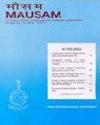Policy Interventions to Address Urban Water Problems of highly urbanised area due to Climate Change
IF 0.7
4区 地球科学
Q4 METEOROLOGY & ATMOSPHERIC SCIENCES
引用次数: 0
Abstract
In this research firstly, the rainfall pattern of Ahmedabad and Surat, the fast-growing urban areas of Gujarat state of India have been studied and compared. It is detected that what makes Surat city more prone to floods. Then, analysis for rainfall shift in Surat over the last three decades has been carried out. It is interesting to observe that the rainfall pattern of Surat is following the local calendar, i.e. Indian calendar rather Gregorian calendar. This relation of rainfall pattern with Indian calendar shows that the prediction and the climatic condition responsible for rain is following the local calendar based on the planetary position. For the Water Sensitive Urban Design, four different wards in Surat Municipal Corporation (SMC) named Adajan, Piplod, Anjana and Pandesara are studied. These wards are selected based on land use, having the highest area in commercial, residential, industrial and institutional in total SMC area. For each ward, the previous and impervious area is calculated, and the runoff is determined. Planning interventions for water sensitive urban design at a building level, street level and ward level have been given for the study area. The study will be definitely helpful for the decision-makers to prepare a policy to follow the local calendar to operate the monsoon protocol and to manage water resource infrastructure, including the planning of harvesting activities.解决气候变化导致的高度城市化地区城市用水问题的政策干预措施
在这项研究中,首先对印度古吉拉特邦快速发展的城市地区艾哈迈达巴德和苏拉特的降雨模式进行了研究和比较。研究发现了苏拉特市更容易遭受洪灾的原因。然后,对苏拉特过去三十年的降雨量变化进行了分析。值得注意的是,苏拉特的降雨模式遵循的是当地日历,即印度历而不是公历。 降雨模式与印度历的关系表明,降雨的预测和气候条件是根据行星位置按照当地历法进行的。为了进行水敏感型城市设计,苏拉特市政公司(Surat Municipal Corporation,SMC)研究了四个不同的区,分别名为 Adajan、Piplod、Anjana 和 Pandesara。这些选区是根据土地使用情况选出的,在苏拉特市政公司总面积中,商业、住宅、工业和机构占地面积最大。每个区都计算了以前的面积和不透水面积,并确定了径流量。对研究区域的建筑物、街道和选区层面的水敏感城市设计进行了规划干预。这项研究必将有助于决策者制定政策,按照当地日历执行季风协议,管理水资源基础设施,包括规划收集活动。
本文章由计算机程序翻译,如有差异,请以英文原文为准。
求助全文
约1分钟内获得全文
求助全文
来源期刊

MAUSAM
地学-气象与大气科学
CiteScore
1.20
自引率
0.00%
发文量
1298
审稿时长
6-12 weeks
期刊介绍:
MAUSAM (Formerly Indian Journal of Meteorology, Hydrology & Geophysics), established in January 1950, is the quarterly research
journal brought out by the India Meteorological Department (IMD). MAUSAM is a medium for publication of original scientific
research work. MAUSAM is a premier scientific research journal published in this part of the world in the fields of Meteorology,
Hydrology & Geophysics. The four issues appear in January, April, July & October.
 求助内容:
求助内容: 应助结果提醒方式:
应助结果提醒方式:


